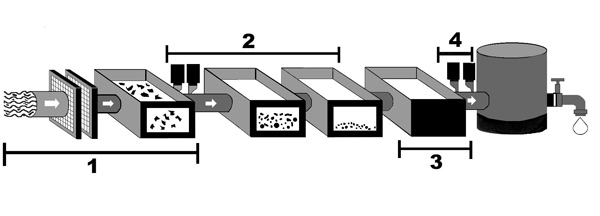
The city of Phoenix provides drinking water to more than 1.7 million people within our 540 square-mile service area. On average, about 95 percent of Phoenix's water comes from surface water (lakes and rivers) and the remaining water comes from groundwater (wells). Each May, the city distributes and posts to the web a
Water Quality Report that contains important information about the quality of your water. Phoenix is committed to providing the highest quality drinking water and service to our customers.
View the most recent Phoenix Water Quality Report
Testing the Water to Ensure Only the Highest Quality
More than five million tests and measurements are conducted each year to ensure high quality tap water in Phoenix. It is tested for more than 100 substances, and is monitored throughout the year to ensure that it meets the rigorous standards set forth by the
U.S. Environmental Protection Agency (EPA), the
Arizona Department of Environmental Quality, and the
Maricopa County Environmental Services Department.
From time to time various groups develop desired standards for drinking water that differ from those established by the EPA. While these theoretical standards may start with good intentions, comparing Phoenix's test results, which are in full compliance with EPA standards, to artificial standards can create confusing, incomplete, and many times extremely misleading information that is unfair to our customers and the city. Be assured that Phoenix complies with current EPA requirements, works with water associations to remain up to date on water quality standards and is committed to protecting public health and safety.
Water Treatment Process Provides Superior Drinking Water
Testing on tap water begins before it enters the water treatment plant. Plant staff works closely with laboratory technicians to determine the composition of the raw water that enters the plant so the treatment process can be fine tuned to ensure that the water is treated effectively to the highest standards. The water is monitored manually and electronically throughout the process to determine if adjustments to treatment must be made. The system used by the city of Phoenix to treat surface water is a highly effective multi-step process, which can be seen in the illustration and explanation below:
Basic Water Treatment Process

Step 1
Screening and Presedimentation -Large particles such as plant matter debris, and other materials commonly found in river water are removed by screens or settle to the bottom of the presedimentation tank.
Step 2
Coagulation, Flocculation and Sedimentation - A chemical coagulant, such as alum or ferric chloride, is added to the water. This causes the tiny particles to cling together and become heavy enough to settle to the bottom of the basin.
Step 3
Filtration - The cleaner water on the top then passes through filters to remove remaining particulate matter.
Step 4
Disinfection -A small quantity of chlorine, a disinfectant, is added to prevent microbial growth. Also a small quantity of fluoride is added to prevent tooth decay.
Sampling and Testing the Water After It Leaves the Plant
After the water leaves the water treatment plant it enters the Phoenix water distribution system, which is comprised of about 7,100 miles of water mains, 70 reservoirs, 110 booster pump stations, 56,000 fire hydrants and 119,000 valves. At numerous points within the system, water quality inspectors take samples of the water, which are then analyzed at the lab to make sure your water continues to meet the highest standards along the many miles it travels to reach your tap.
Maintaining Our Distribution System to Ensure Continued Water Quality and Reliability
As part of the process of maintaining the high quality water and the integrity of the water distribution system, staff will flush the system in strategic locations so that the water quality is maintained. Crews from our Water Distribution Division also work hard to make sure that leaks in our water system never impact the delivery to your tap. And while there are times that water outages do occur due to aging lines or accidents, we do our best to keep customers informed and outage times short.
EPA regulations require the Phoenix Water Services Department to publish a Consumer Confidence Report, which is also known as a Water Quality Report. The report is distributed each May and encompasses important information about Phoenix water for the previous year. Review the most current water quality report.
Click Here to: Request a printed copy of the most recent Phoenix Water Quality Report
Additional Information on Water Quality Issues
Phoenix Water Services Department Environmental Services Division
Safe Drinking Water Act (EPA)
Arizona Department of Environmental Quality
National Science Foundation
Tap Into Quality
